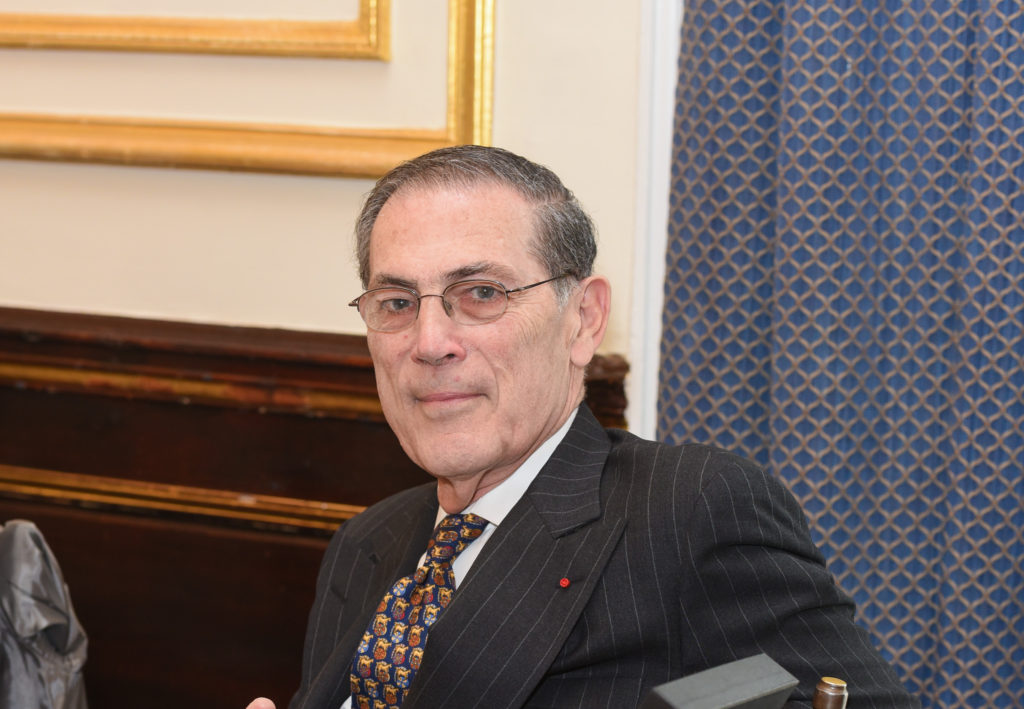Opinion
The Gray Market: Why We Shouldn’t Punish Small Museums for Deaccessioning (and Other Insights)
This week, our columnist teases out the controversies at the Berkshire Museum and the APT, and considers Philippe de Montebello's new job.

This week, our columnist teases out the controversies at the Berkshire Museum and the APT, and considers Philippe de Montebello's new job.

Tim Schneider

Every Monday morning, artnet News brings you The Gray Market. The column decodes important stories from the previous week—and offers unparalleled insight into the inner workings of the art industry in the process.
This week, digging into public statements in search of a fuller truth…
TURNABOUT ISN’T FAIR PLAY: On Tuesday, a pair of influential institutional groups chastised Massachusetts’s Berkshire Museum over its plans to auction 40 of the roughly 2,400 works in its permanent collection to replenish its endowment and fund an architectural expansion. And the righteous indignation on display once again resurrected one of my favorite double standards in the nonprofit space.
To review, the American Alliance of Museums (AAM) and the Association of Art Museum Directors (AAMD) contend that their member institutions should only deaccession—see: release and resell—artworks in their holdings for the express purpose of either acquiring new works or, in the AAM’s case, caring for existing works. Flip pieces for any other reason—no matter how dire the financial circumstances—and affiliated museums are almost certain to face sanctions, most often in the form of being temporarily blacklisted from receiving artwork loans from members in good standing.
In a joint statement, the AAM and AAMD argued that the Berkshire’s decision to consign works by the likes of Albert Bierstadt, Alexander Calder, and Norman Rockwell to Sotheby’s “sends a message to existing and prospective donors that museums can raise funds by selling parts of their collection, thereby discouraging not only financial supporters, who may feel that their support isn’t needed, but also donors of artworks and artifacts, who may fear that their cherished objects could be sold at any time to the highest bidder to make up for a museum’s budget shortfalls.”
It’s an ideologically pure, dependably crowd-pleasing position to take. Its naiveté also makes me want to start throwing large objects long distances out high windows.
First, telling small museums like the Berkshire that deaccessioning to fundraise will repel significant donors is like telling people with low self-esteem to stop masturbating because it will repel willing hookup partners. Why? Because this sage advice ignores that, if the right counterparts were making the right offers at the right times, the folks in question probably wouldn’t resort to these alternate solutions in the first place.
So in our increasingly winner-take-all, public-sector-give-little society, it’s an inversion of cause and effect to suggest that major gifts won’t flow in to the Berkshire because it’s selling a fraction of its collection to shore up operations. In my view, that’s a big policy problem.
Second, let’s talk about the AAM and AAMD’s blanket deification of collectors: these saintly beings who would nearly die from the crassness of their donated works’ being treated as, to quote another part of the joint statement, “disposable financial asset[s].”
To be clear, there are many collectors who gift works to museums because they genuinely want those works to benefit the masses. I applaud these people until my hands are numb from the striking, and always will. In their case, the AAM and AAMD’s stance is defensible.
However, there are also many collectors who gift works to museums in large part TO TRANSFORM THEM INTO disposable financial assets. Remember, in the US, single collectors can donate artworks to institutions for tax deductions equal to said works’ appraisable value. So if a massive write-off would be useful in your accountant’s eyes, what better way to “earn” it than to flip a piece or two to an eager museum with the help of a willing appraiser or a few outsize auction results?
In fact, for a recent example, we need to look no further than one of the week’s other big stories: a Canadian government review board’s decision to deny “culturally significant” status to a would-be gift of over 2,000 Annie Leibovitz photographs to the Art Gallery of Nova Scotia—likely because, per a source for the Canadian Broadcasting Corporation, the panel saw the donation as a huge “tax grab.”
While Canadian regulations in this realm are stricter than American ones, the CBC reports that, if certified, the Leibovitz collection could still snag its would-be donors, the Mintz family, “a tax refund/credit…up to double what they paid.” And that prospect becomes even more sobering when you know that the agreed-upon purchase price was USD 4.75 million… for a collection independently appraised by three different sources at USD 20 million.
In light of this, maybe you can understand why I fundamentally disagree with the AAM and AAMD’s warnings to the Berkshire. I wish we lived in an art world where beauty and principle overruled raw financial interest at every turn. But we don’t.
Given that reality, I think we should at the very least stop penalizing and ostracizing small, struggling museums that are only responding reasonably to similar incentives as tax-savvy collectors. Like it or not, name-brand art is currency in 2017. And if our policies dictate that wealthy private citizens and corporations alone should be allowed to freely capitalize on the exchange rate, we’re only reinforcing the same polarization distorting the art industry and the larger economy. [The New York Times]

A work by Jeremy Deller that was among 18 withdrawn from a Sotheby’s auction on April 12 in London. Courtesy the artist and Sotheby’s.
STORAGE WARS: On Friday, my colleague Colin Gleadell covered the latest controversy to erupt from the increasingly beleaguered Artist Pension Trust: a newly announced policy to charge its participating artists $6.50 per stored artwork per month beginning September 1, 2017—unless the artists agree by August 11 to arrange their own storage elsewhere at their own expense.
As a refresher, the APT runs an alternative business model in which approved artists agree to contribute an average of one work per year to the Trust for two decades. While artists were just recently granted the option to influence the APT’s sales strategy for their contributed works, should they decline, it’s up to the Trust’s managers to try to build value in the collection over many years, sell individual works at or near their peak prices, and—no matter how the sales are made—distribute the proceeds to all contributing members rather than just the specific creators of the sold works.
In short, it’s a “strength in numbers” concept whose resources have swollen to about 13,000 artworks by 2,000 artists since the APT’s founding in 2004. As Gleadell notes, about 13,000 artworks at $6.50 in monthly storage costs per work would amass over $1 million per year in fees for an entity that looks increasingly like it could desperately use the cash. And the revenue potential only becomes harder to overlook considering that the Trust’s revised policy was announced without prior warning to, or consultation with, its artists.
Al Brenner, CEO of the Trust’s managing entity, MutualArt, argues that the storage-fee policy is “not about raising money to balance our books,” but rather about motivating artists “to get the work out of storage so that it can be seen and eventually sold. Some works have been in storage for ten years and that’s not good.”
In principle, Brenner’s not wrong. But the accuracy of his statement also implies to me that there’s more going on here than meets the eye, even if some sociopath were trying to paper-cut your retinas with a storage-cost spreadsheet.
After nearly 10 years in the gallery sector, here’s what I can say with confidence about dealers’ decision tree for inventory sourced from artists: If you can sell it yourself now, you install it. If you DON’T think you can sell it yourself now, you either consign or store it. But if you don’t think you can sell it EVER, you send it back to its maker like a salad with a dead mouse nested in the greens.
This is why almost any time a gallery prepares to cut ties with an artist, one of its first moves is to return much or all of said artist’s work to the studio. Storage space is valuable, therefore expensive, therefore (in an ideal world) reserved for works that can provide a decent return on investment in the not-too-distant future.
So while I can’t prove it, I suspect this policy shift is as much about the APT’s desire to separate the (potential) stars from the satellites as it is about just recouping cash. Especially because a less crowded artist list provides two major incentives for the more marketable artists to stay put while their irritated peers stream out the door.
First, if artists whose works were languishing in storage decide to leave with their output in tow, the trust’s specialists no longer have to spend their limited resources on marketing, administrating, or maintaining either one. This means they can instead devote more time, energy, and capital to artists and inventory likely to sell well.
Further, more-marketable artists are likely to be less disgruntled over the new storage fees because: A) they probably have more capital than their less-visible peers at this point anyway, due to stronger sales inside and outside the Trust, and B) their works are probably circulating around the industry more, as well, since the APT and its affiliates believe they can actually sell them.
Second, from what I can tell based on the APT’s distribution structure, the more artists withdraw from the trust, the more money the artists who stay put stand to make based on each sale. (Note: I emailed APT to try to confirm my interpretation of their terms, but had not heard back by my deadline. Either way, I’ll update my post on this accordingly if and when a reply comes in.)
For a clearer view of the why and how, consider the answer to the question “Is it possible for an artist to remove [sic] from APT?” in the Trust’s current FAQ (emphasis mine):
“APT designed a program that rewards loyalty to the plan and the artists who participate. We cannot guarantee the benefits to artists who withdraw from the program. An artist whose request to withdraw has been accepted by APT could still receive 40% of the future sale of any of his/her artworks deposited prior to withdrawal but will no longer be considered as part of the trust and will no longer receive distributions made to trust participants. Artwork already deposited will still considered to be part of that trust’s collection.”
Here’s what the bolded section means in the context of the APT’s larger payment plan: For each sale, the artist who actually created the work in question receives 40 percent of the proceeds. The other participating artists in the Trust receive 32 percent, with the actual dollar amount pro-rated based on the number of artists. (The APT itself receives the other 28 percent.)
Now think about a hypothetical sale by the Trust of a work that nets $100,000. The first $40,000 goes to the artist who made the piece. The last $28,000 goes to the Trust. And the dollar value of the 32 percent owed to the other participating artists—$32,000—doesn’t change, no matter how many people make up this group.
But if, say, 16 of these 32 artists bailed on the APT in protest before the sale was made—either because of the storage fee specifically or their treatment more broadly—the 16 artists who stuck around would net twice as much cash ($2,000 each) from the sale than if everyone had stayed in the boat together ($1,000 each). Not a bad reason to weather a little storm surge, right?
All in all, then, my hunch is that the storage fee is not just about trying to minimize APT’s downside risk with a new revenue stream. It’s also about trying to hone their specialists’ focus and convince their most sellable contributors to stand pat, in part by provoking less marketable artists to voluntarily opt out of an oversaturated and overburdened collection.
But even if I’m wrong, the incentives are set up to encourage this path. And once people see how the cards have been dealt, their responses usually aren’t based on whether it was the result of intention or accident anyway. [artnet News]

Philippe de Montebello. Photo Presley Ann/PMC.
ACQUA MAN: Finally this week, in perhaps the most noteworthy art-world border crossing since Joseph Beuys was wheeled off a plane to JFK and deposited into a cage with a live coyote, on Wednesday former Metropolitan Museum of Art director Philippe de Montebello was named a director of stately heavyweight gallery Acquavella “effective immediately,” per Robin Pogrebin.
The 81-year-old de Montebello’s responsibilities in his new post will reportedly include “the curation of special exhibitions and the development of publications.” But I think even this relatively narrow focus can be shaved down further, with nuanced implications for the state of the gallery sector as a whole.
Although my impression has always been that de Montebello is tremendously (and deservedly) respected around the industry, postwar and contemporary specialists also know that he’s not exactly a raving fanboy of their genre. Michael Kimmelman referenced de Montebello’s career-long “discomfort with contemporary art” in a piece about his Met retirement announcement in 2008, and the man himself was quoted in a 1997 New Yorker profile candidly stating, “I know who the [post-1960s] artists are…I recognize their works when I see them, but I must admit that, no, it doesn’t do it for me.”
This aspect of de Montebello’s worldview should clearly demarcate which side of Acquavella’s century-plus-spanning artist list he’ll stay on: Picasso over Polke, Toulouse-Lautrec over Twombly, or if you’ll allow me to analogize his tastes to Wesley Snipes in Passenger 57, I’ll just say this: Always bet on Braque.
Yet I haven’t seen any explicit indication that de Montebello will silo with the dead, least of all in his actual title. Which shouldn’t come as a surprise. On the “Gallery” page of its website, Acquavella also boasts four other directors—none of them with any further specialty or scope of work publicly defined. All we’re told is that “their combined experience represents a wide range of expertise in acquisition, appraisal, and education,” and that “business can be conducted in French, Italian, Japanese, Mandarin, Taiwanese, Spanish, and English.”
But who should someone talk to about what, and in which language? Those answers are any outsider’s guess.
Both Acquavella’s proliferation of directors and the opacity about their specialties are par for the course in the 21st century gallery sector. Mega-galleries generally have more directors than physical locations—for instance, David Zwirner currently lists eight, excluding lower-ranking staffers like “Director of Sales” and “Associate Director.” Even some midsize, single-location galleries now include multiple unspecified directors in their org charts.
In some sense the blanket title is a vestige from a more intimate, less corporate era, when successful (or at least influential) galleries could still be managed day-to-day by a single person. Today, though, galleries have to do too much in too many places too fast to rely on single-source leadership. So one director becomes two becomes five (or more) before you know it.
But I also think the commitment to clubbiness—i.e. to the rarefied socioeconomic set that I call Camelot—plays a role, too. Many gallerists would argue that there’s no need to more clearly label who does what for them because, if a collector or industry professional matters, they should ALREADY KNOW. And if they don’t, then they deserve to be thrust into the severe information asymmetry that defines so much of the private art trade in 2017.
In that sense, Acquavella’s tagging de Montebello as simply “a director” is enough. Insiders broadly understand which artists he’s there to handle, whether it’s officially stated or not. But if you’re a rookie, then at least now you know that, if you’re hot after something as recent as Mike Kelley’s Master Dik, it’d be a major boner to phone up Philippe. [The New York Times]
That’s all for this edition. Til next time, remember: The obvious facts are usually just a starting point.